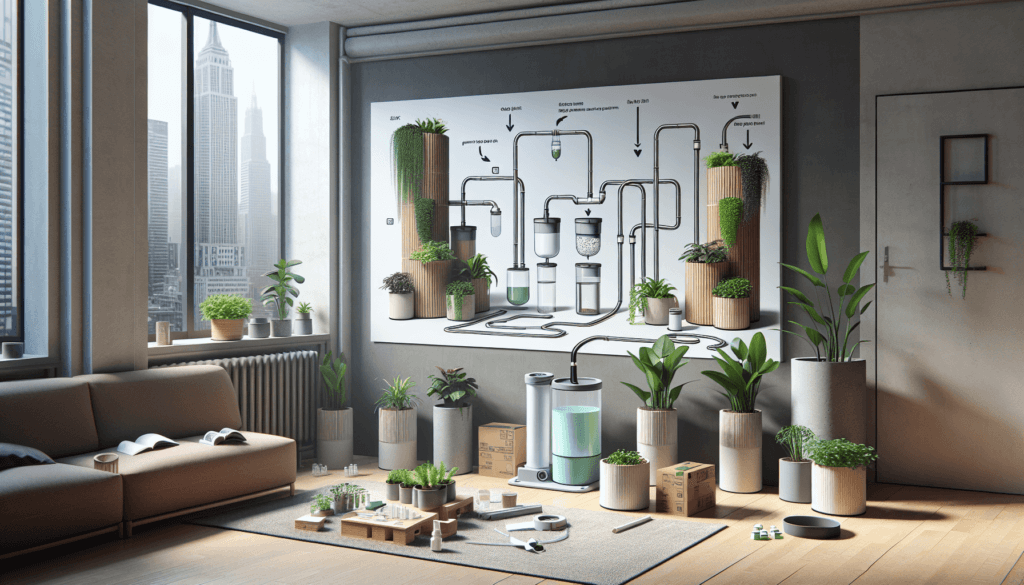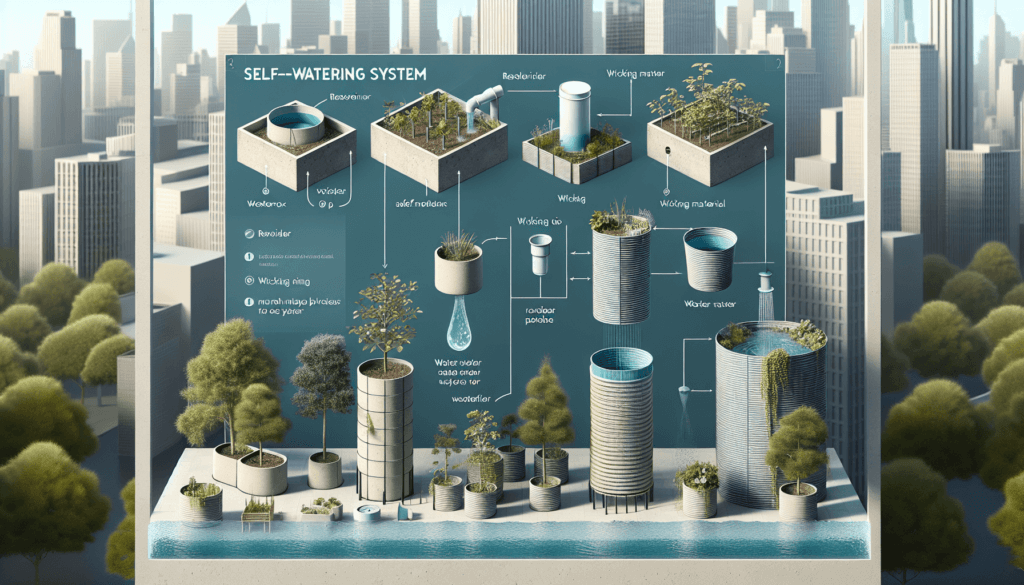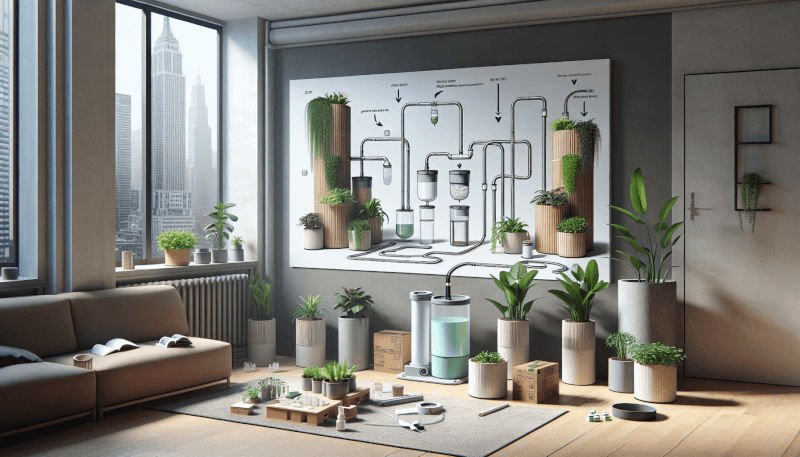Do you struggle to keep your urban planters hydrated and thriving? Look no further! This article offers an easy-to-follow DIY guide on creating a self-watering system for your urban planters. Say goodbye to constantly worrying about watering your plants and hello to convenient and efficient plant care. With just a few simple steps, you’ll be able to create a self-watering system that ensures your plants receive the right amount of hydration even when you’re busy or away. Get ready to transform your urban planters into self-sufficient green oases!

Materials Needed
To create a self-watering system for your urban planters, you will need several materials:
Plastic containers
Choose plastic containers that are suitable for your plants’ size and the available space. Opt for containers with ample drainage holes to ensure proper water flow.
Waterproof sealant
To prevent water leakage, you’ll need a waterproof sealant. Look for a sealant specifically designed for outdoor use, as it will be more resistant to weather conditions.
Plastic tubing
Plastic tubing is essential for circulating water from the reservoir to the plants. Select tubing with the appropriate diameter to fit the watering mechanism and container.
Drill
A drill will be necessary to create holes in the containers and install the tubing. Ensure you have the correct drill bit size for the tubing diameter.
Water reservoir
Choose a water reservoir that holds an adequate amount of water for your plants’ needs. Consider the size and weight of the reservoir to ensure it fits comfortably with your planter.
Watering mechanism
The watering mechanism is the heart of your self-watering system. You can opt for a drip irrigation system, wick system, or other automated watering systems available in garden stores.
Water level indicator
A water level indicator helps you monitor the water level in the container. It ensures you don’t overwater or underwater your plants. Select an indicator that is easy to read and install.
Timer
Incorporating a timer will automate the watering process. Choose a timer that suits your needs and has flexible programming options.
Planting medium
Organic soil mixed with additives like compost or peat moss provides the necessary nutrients for your plants. Ensure the planting medium is suitable for your specific plants’ requirements.
Plants
Lastly, choose plants that thrive in your specific environment and are suitable for container gardening. Consider factors such as sunlight exposure and watering needs when selecting your plants.
Choosing the Right Container
Selecting the appropriate size
When choosing a container, consider the space available for gardening and the size of the plants. Make sure the container is large enough to accommodate the plants’ root systems and allow for proper growth.
Ensuring proper drainage
Proper drainage is crucial to prevent waterlogging, which can lead to root rot and other plant diseases. Ensure the container has drainage holes at the bottom or along the sides.
Opting for durable materials
Choose containers made of durable materials, such as UV-stabilized plastic. This ensures the containers will withstand outdoor conditions and last for a longer time. Additionally, consider containers with a self-watering feature to optimize water distribution.
Sealing the Container
Cleaning the container
Before applying the waterproof sealant, clean the container thoroughly to remove any dirt or residue. Wash it with mild soap and water, then rinse and dry completely.
Applying waterproof sealant
Apply the waterproof sealant to the inside of the container, focusing on the areas where water might penetrate. Ensure an even and thorough coating, following the manufacturer’s instructions.
Allowing sufficient drying time
After applying the sealant, allow the container to dry completely. This drying time is crucial to ensure the sealant forms a strong barrier against water leakage. Follow the manufacturer’s recommended drying time before proceeding to the next steps.
Drilling Holes for Tubing
Determining tubing placement
Decide where you want to position the tubing in the container. This will depend on the type of watering mechanism you choose and the plants’ watering requirements.
Marking the drilling spots
Using a marker or pencil, mark the spots where you will drill holes for the tubing. It’s essential to space the holes evenly and consider the tubing’s diameter to ensure a proper fit.
Using a drill to create holes
With the appropriate drill bit for the tubing diameter, carefully drill holes in the marked spots. Take caution not to create holes that are too big or too close together, as this may compromise the container’s structure.

Installing the Water Reservoir
Selecting an appropriate reservoir
Choose a water reservoir that holds an adequate amount of water for your plants’ watering needs. Consider the size and weight of the reservoir in relation to the container and ensure it fits securely.
Positioning the reservoir
Place the water reservoir near the container, ensuring that it is easily accessible for refilling. Consider factors such as aesthetics, convenience, and functionality when choosing the position.
Attaching the tubing to the reservoir
Connect one end of the tubing to the water reservoir, ensuring a tight and secure fit. You may need to use additional connectors or adapters, depending on the reservoir and tubing types.
Implementing the Watering Mechanism
Choosing the type of watering mechanism
Select a watering mechanism that suits your plants’ watering needs and your personal preferences. Drip irrigation systems are popular choices for self-watering containers, as they provide a controlled and efficient water supply.
Installing the mechanism in the container
Follow the manufacturer’s instructions to install the watering mechanism in the container. This may involve inserting drippers, wicks, or other components into the planting medium or attaching the mechanism to the container.
Connecting the mechanism to the tubing
Attach the tubing from the watering mechanism to the holes drilled in the container. Ensure a secure connection to prevent leaks. Test the system by pouring water into the reservoir and checking for proper water flow.

Adding a Water Level Indicator
Selecting a suitable water level indicator
Choose a water level indicator that suits your preferences and is compatible with your container and system. Options include float valves, probes, or simple dipstick-style indicators.
Installing the indicator in the container
Follow the manufacturer’s instructions to install the water level indicator in the container. This typically involves inserting the indicator into the planting medium, ensuring it is easily visible and accessible.
Calibrating the indicator
Once installed, calibrate the water level indicator according to the manufacturer’s instructions. This ensures accurate readings and helps you determine when it’s time to refill the water reservoir.
Incorporating a Timer
Choosing a timer
Select a timer that fits your system’s requirements and offers the programming options you desire. Consider timers with multiple functions, such as adjustable intervals and rain delay features.
Positioning and connecting the timer
Find an appropriate location for the timer, ensuring it is protected from the elements and easily accessible. Connect the timer to the water reservoir and follow the manufacturer’s instructions for wiring.
Setting the timer intervals
Program the timer according to your plants’ watering needs and environmental conditions. Experiment with different intervals and durations to find the optimal watering schedule.

Preparing the Planting Medium
Selecting appropriate soil and additives
Choose a high-quality soil mix suitable for container gardening. Consider adding organic matter such as compost or peat moss to improve moisture retention and nutrient availability.
Mixing the planting medium
Thoroughly mix the soil and additives in a separate container or wheelbarrow. Ensure an even distribution of the additives throughout the soil mix, creating a balanced and fertile planting medium.
Filling the container with the medium
Fill the container with the planting medium, leaving enough space for the plants’ root systems. Gently firm the soil and ensure it is evenly spread, avoiding air pockets that may disrupt water flow.
Planting and Maintaining the Plants
Choosing suitable plants
Select plants that are appropriate for your specific environment and container gardening. Consider factors such as sunlight requirements, water preferences, and compatibility with the self-watering system.
Planting the plants in the container
Carefully plant the selected plants in the prepared container, ensuring they are positioned at the appropriate depth and spacing. Press the soil gently around the roots to secure them in place.
Regularly monitoring and adjusting watering needs
Observe your plants regularly and adjust the watering schedule as needed. Check the water level indicator and refill the reservoir when necessary. Pay attention to any signs of over or underwatering, and make adjustments accordingly.
Creating a self-watering system for your urban planters offers convenience and ensures optimal watering for your plants. By following this comprehensive guide and selecting the right materials, you can enjoy thriving urban gardens with less effort and worry. Happy gardening!



